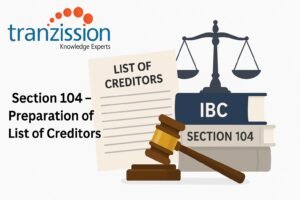
Role of Bankruptcy Trustee in Ibc
Table of Contents
An individual or a partnership firm is bankrupt when it is unable to meet its financial obligations and has insufficient assets to cover its debt. The corporate debtor initiates the bankruptcy procedure by filing a petition with the Adjudicating Authority, the National Company Law Tribunal (NCLT). The NCLT will assess and value the debtor’s assets, some of which may be used to settle debts. A Role of Bankruptcy Trustee in Ibc trustee will be appointed to manage the bankrupt individual or partnership firm during this process and ensure it is conducted fairly and transparently.
What is a Bankruptcy Trustee?
A bankruptcy trustee as per section 79(9) of the Insolvency and Bankruptcy Code, 2016 (IBC) is the insolvency professional appointed by the NCLT as a trustee for the estate of the bankrupt to oversee the bankruptcy resolution process of individuals or firms.
Legal Framework of Role of Bankruptcy Trustee in Ibc
The role of the Role of Bankruptcy Trustee in Ibc and their appointment is governed under the IBC:
Section 149 of the IBC:
Section 149 of the IBC lists the functions of the Role of Bankruptcy Trustee in Ibc, which is to investigate the affairs of the bankrupt, realise the estate of the bankrupt, and distribute the estate of the bankrupt.
Global Perspective:
Each country has its bankruptcy laws, having the powers and responsibilities of a Role of Bankruptcy Trustee in Ibc, the procedure to appoint them, and their duty to maximise the return on assets to satisfy the creditors’ claims. Bankruptcy trustees in India have similar responsibilities to other countries, especially in managing the debtor’s assets, maximising creditor recoveries, and upholding fair and transparent bankruptcy processes, thereby aiming for a level of uniformity with cross-border cases.
Appointment of a Role of Bankruptcy Trustee in Ibc
Eligibility and Qualifications:
According to section 125 of the IBC, an insolvency professional can be appointed by the NCLT to be a Role of Bankruptcy Trustee in Ibc. Therefore, an individual must be enrolled as an Insolvency Professional Agency member and registered with the Insolvency and Bankruptcy Board of India (IBBI) as per section 206 of the IBC.
Process of Appointment:
Section 125 provides that an insolvency professional may be proposed to be appointed as the bankruptcy trustee. On an application under section 122 and section 123, the NCLT shall direct the IBBI within 7 days of receiving the application for bankruptcy to confirm, that no disciplinary proceedings are pending against such a professional. As per section 125(2), if the applicants propose no insolvency professional to nominate a bankruptcy trustee. The IBBI shall within 10 days either confirm or reject the appointment. The NCLT shall pass a bankruptcy order within 14 days of receiving the confirmation or nomination that appoints an insolvency professional as the bankruptcy trustee.
Read more : Offences and Penalties under IBC, 2016
Key Functions of a Bankruptcy Trustee
Under the IBC, the functions of a bankruptcy trustee include asset management, representing the creditors during the bankruptcy process, monitoring the process, and distributing the assets among the creditors:
- Asset Management: The bankruptcy trustee takes control of the debtor’s assets to prevent mismanagement or diversion and ensure the valuation of assets to maximize recoveries.
- Representation of Creditors: They also communicate with the creditors, providing them with information about the bankruptcy proceedings. A bankruptcy trustee acts as the representative of creditors, safeguarding their interests during the bankruptcy process. They convene and preside over the meetings to decide on the course of action of the procedure.
- Oversees the Bankruptcy Process: An individual appointed as a bankruptcy trustee conducts investigations to identify fraudulent transactions or hidden assets They also ensure compliance with bankruptcy laws and timelines under the IBC.
- Distribution of Recoveries: At the last stage of the bankruptcy process, bankruptcy trustees facilitate equitable distribution of the debtor’s assets among creditors and ensure claims, such as employee wages or secured creditors, are addressed first.
Powers of a Bankruptcy Trustee
Section 152 of the IBC lists the general powers of the bankruptcy trustee, which can be categorised under these headings:
- Control Over Assets: The primary power of a bankruptcy trustee is to acquire possession of the debtor’s assets, books, and records and it recover assets transferred under fraudulent preferences.
- Legal Authority: During the bankruptcy process, the bankruptcy trustee has the responsibility to file and defend legal suits on behalf of the debtor’s estate. They can also challenge transactions that undermine creditor rights such as preferential or undervalued transactions.
- Administrative Powers: The bankruptcy trustee has administrative powers such as negotiating with creditors to formulate a repayment or restructuring plan and reports to the NCLT on the progress of bankruptcy proceedings.
Challenges Faced by Bankruptcy Trustees
Under the IBC, there are several practical challenges that a bankruptcy trustee faces regarding the complexity of bankruptcy cases, dealing with insufficient information from stakeholders, and legal and procedural delays.
- Complex Cases: Managing bankruptcy cases, particularly those involving cross-border insolvency or multiple creditors with conflicting interests, may be difficult for a bankruptcy trustee. Cases that involve complex corporate structures or large companies can also make the process more complex.
- Insufficient Information: A bankruptcy trustee may face difficulties in locating and recovering hidden or undervalued assets. This hinders their assessment of the debtor’s assets and liabilities which potentially leads to delays in the bankruptcy process and missed opportunities to maximise recoveries for creditors.
- Legal and Procedural Delays: Lengthy litigation due to its complexity and delays in approvals from the NCLT hinder timely resolution by obstructing the efficient liquidation of assets, increasing the costs for creditors, and potentially reducing the overall rate in a bankruptcy estate.
Case Studies: Practical Insights into the Role of Trustees
- Fraudulent Transactions in Bankruptcy: In a prominent case against a wealthy business leader, the bankruptcy trustee was able to uncover instances where the tycoon had transferred property at significantly below market value. This allows them to reclaim those assets and distribute funds to the debtor’s creditors, effectively safeguarding their interests despite the bankruptcy filing. The bankruptcy trustee successfully identified undervalued property transfers, ensuring recoveries for creditors.
- Creditor Protection: A bankruptcy trustee also ensures that the rights of the creditor are protected during the bankruptcy process. In a liquidation case, the trustee’s proactive asset management prevented further depreciation, leading to higher recovery rates.
Importance of Bankruptcy Trustees in the IBC Ecosystem
A bankruptcy trustee plays a crucial role under the IBC by acting as a neutral administrator, taking control of a bankrupt’s assets, and ensuring that the assets are fairly distributed among creditors.
- Maintaining Transparency: Such an insolvency professional ensures that all financial information related to a corporate debtor’s assets is accurately disclosed. This allows creditors to have a clear understanding of the financial situation of the bankrupt individual. Hence, they ensure accountability throughout the bankruptcy process by preventing fraudulent practices and promoting fair dealings.
- Facilitating Creditor Confidence: Bankruptcy trustees strengthen the insolvency ecosystem by protecting creditor interests and ensuring timely resolutions.
- Upholding Legal Mandates: As per the functions and powers of the bankruptcy trustee under the IBC, bankruptcy trustees ensure strict compliance with the IBC provisions, and related rules and regulations. This facilitates consistency in bankruptcy proceedings.
Recommendations for Enhancing Trustee Effectiveness
According to the gaps in insolvency and bankruptcy laws as well as the challenges that a bankruptcy trustee faces, recommendations to enhance their effectiveness include:
- Capacity Building: It is recommended that the IBBI conduct training programs to equip trustees with skills in asset management, valuation, and forensic investigations.
- Technological Integration: Bankruptcy trustees can utilise technology such as artificial intelligence and blockchain technology to streamline asset tracking and record-keeping, reducing the time for the bankruptcy process.
- Legislative Support: The current insolvency and bankruptcy laws need to be amended to simplify the appointment and reporting processes, thereby minimising bureaucratic hurdles.
Conclusion
Bankruptcy trustees are integral to the success of insolvency and bankruptcy processes under the IBC. Such an insolvency professional is appointed to manage the bankruptcy process of an individual or partnership firm. They are primarily responsible for investigating the bankrupt’s affairs, realising their assets, and distributing the proceeds to creditors fairly and impartially.





